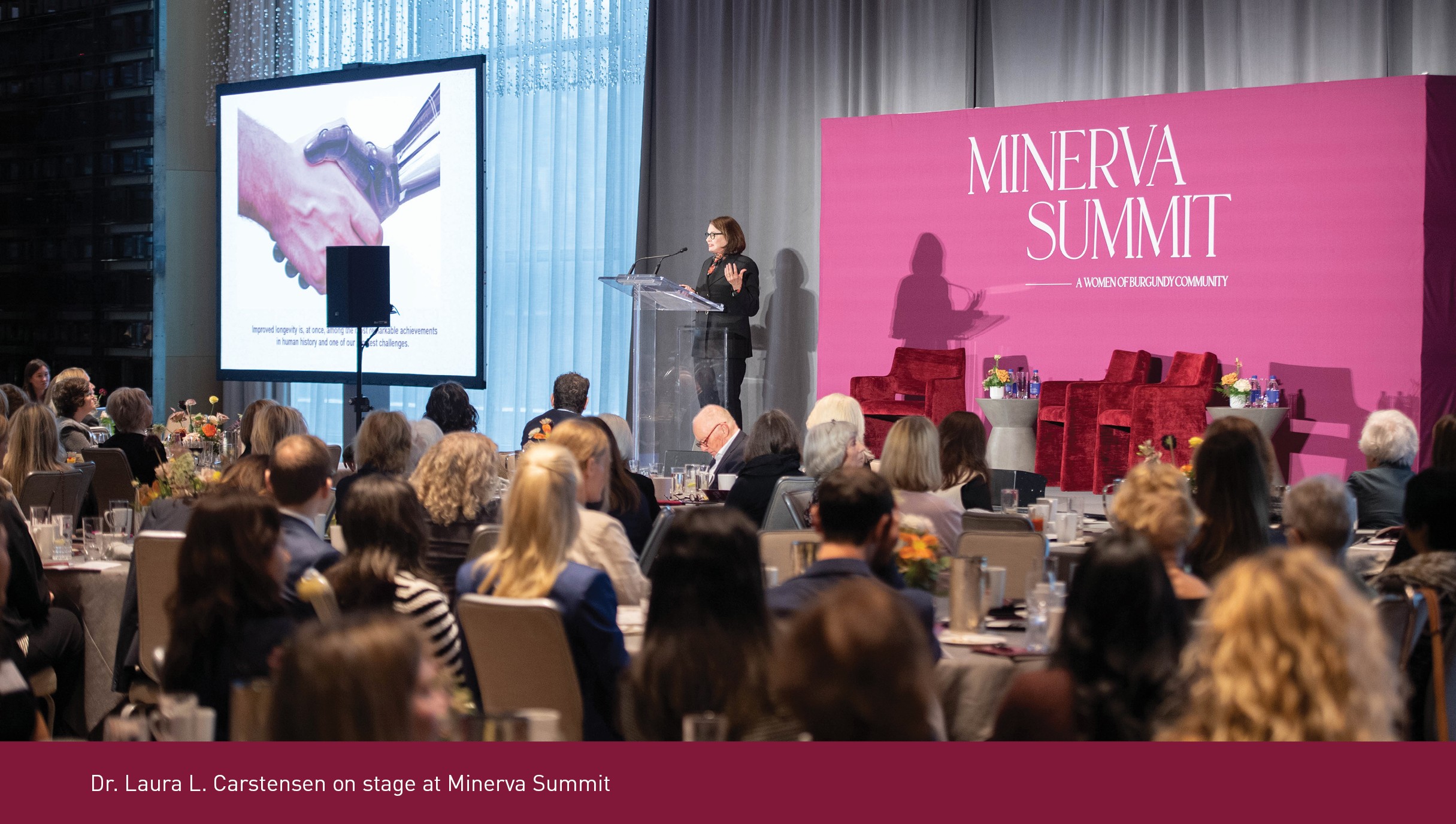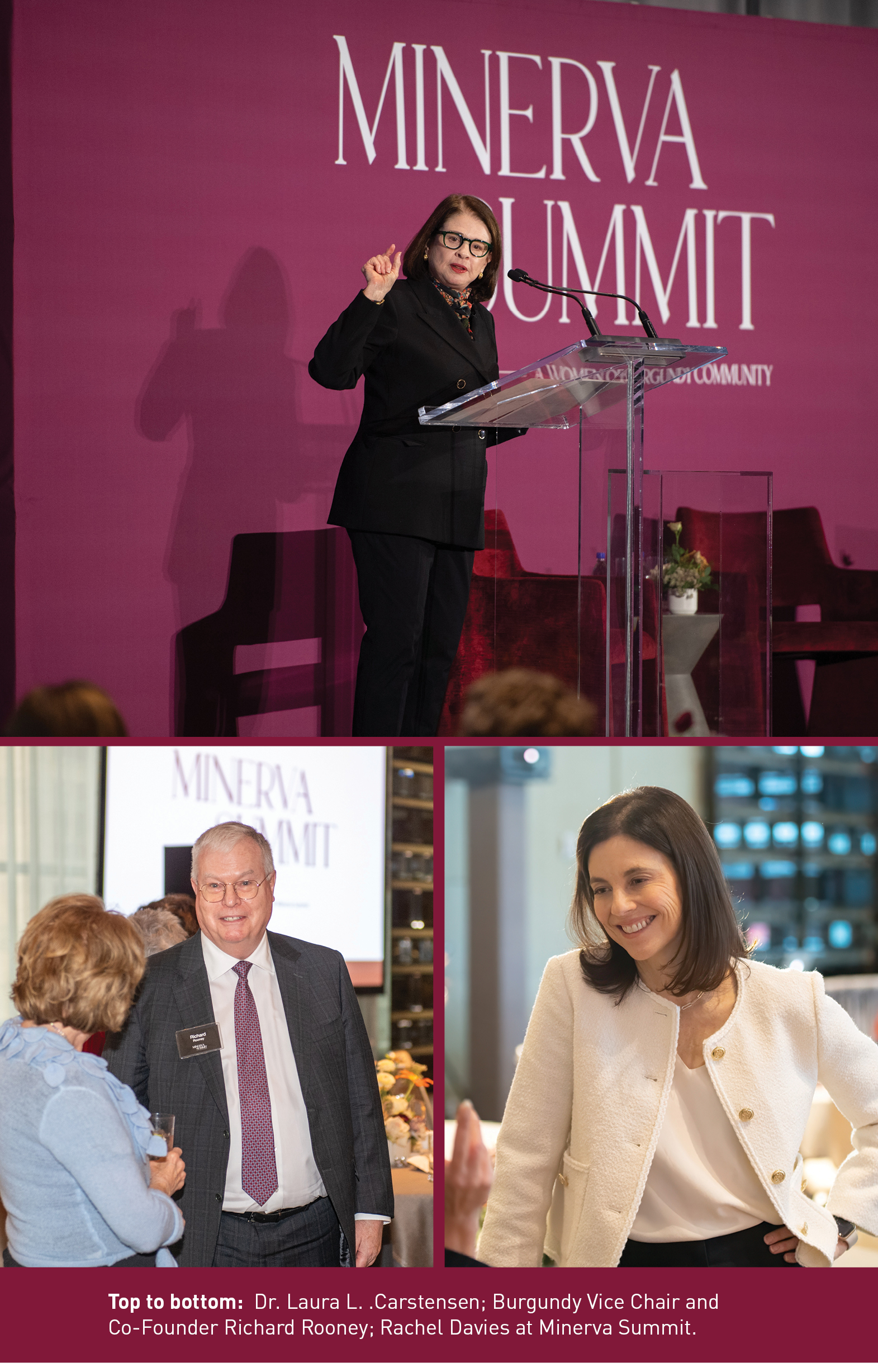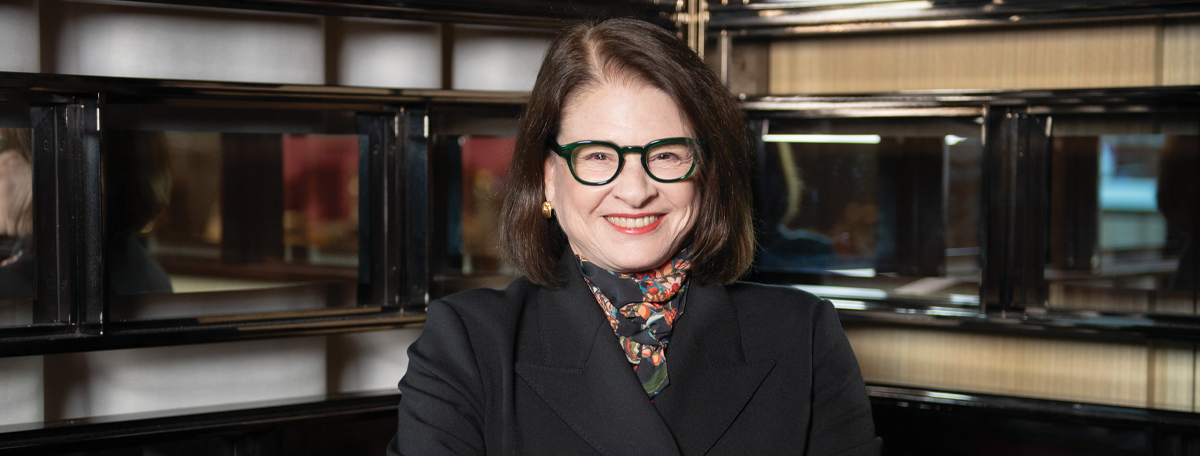With lifespans continuing to rise, wealth management demands even more of our attention. As part of Burgundy’s commitment to helping clients plan for longer lives—enabling them to live as they wish and give as they wish—we are pleased to share the keynote address from Minerva’s most recent Summit, where Stanford professor Dr. Carstensen delivered a compelling keynote on aging. With insights into the cognitive, emotional, and motivational aspects of getting older, along with strategies for making the most of these extra years, Dr. Carstensen is reimagining the aging experience.
Dr. Laura L Carstensen: Living longer is one of humankind’s most remarkable achievements. It’s also one of the greatest challenges of the 21st century. We’re living longer today than my great-grandmother ever could have imagined. In fact, I wish I could tell her, “Grandma, the babies are surviving,” because back in her day, many of them didn’t. Just over 100 years ago, about 25 percent—one in four—of these little ones died before they reached age five, and many more died before 12. Back then, death was common at all ages; it wasn’t strongly associated in people’s minds with old age because people often died at any time. And then, in just one century, we added 30 years to the average human life expectancy.
Over the millennia, life expectancy inched up at a snail’s pace. By the mid-1800s in Europe, it reached the mid-30s. In 1900 in the United States, it was 47. By the end of that century, it had climbed to 77. Today it’s 79 in the U.S., and even longer in Canada. We added more years to life expectancy in the 20th century than we added across all prior millennia of human evolution combined. In the blink of an eye, historically speaking, we nearly doubled the length of our lives.
This, I argue every chance I get, is our challenge. We’re still following social norms that tell us when to get an education, when to marry, when to have children, and when to retire—norms that worked when life expectancy was 50, but don’t work when it’s approaching 100 for many people. We are also born into worlds that were literally designed by and for young people. When you’re climbing a flight of stairs and your knees are hurting, it’s not you—it’s the stairs. The presumed users were very young. The same goes for the knowledge housed in our medical school libraries: We know a lot about acute diseases, but not much about chronic ones, creating this gap between lifespan and healthspan.
Some of you might feel uneasy about growing older, so let me tell you a story about Jeanne Louise Calment. She died in 1997 at the age of 122, holding the record for the oldest documented human ever. She lived in the French city of Arles, in her family home. She was remarkable. She rode a bicycle until she was 110 and made a rap album at 114. She even starred in the movie Vincent and Me because she had actually met Van Gogh, making her the oldest actress of all time. But my favourite story about her involves a property deal she made at age 90.
She was living in her family home, determined to stay there for the rest of her life, when a 47-year-old lawyer who desperately wanted to buy the house kept making her offers. She kept turning him down. Then one day, he showed up at her door and said, “I’ve got a proposition for you. I will pay you $400 a month for the rest of your life if you will deed the house to me on your death.”
She thought about it and agreed. They signed the contract. Over the next 30 years, he paid her more than three times the value of her home. And here’s the kicker—she outlived him by two years. He died at 77, which was average life expectancy at the time. This is what 122 can look like.
People often ask me: “With everyone living so long, isn’t overpopulation going to be a terrible problem?” But the answer, surprisingly, is no. During the same period that life expectancy increased, fertility rates fell by half in most developed countries.
In the United States in 1900, women had an average of 4.2 children. By century’s end, that number had dropped to 2.1. In Canada today, the fertility rate is even lower at 1.2—well below the replacement rate. When each generation is smaller than the last, it doesn’t take long for population numbers to decrease significantly. In fact, some government leaders and public figures are sounding alarm bells about this population decline.
“We’re standing at a unique moment in human history where, for the first time, four or even five generations are alive simultaneously.”
This demographic shift has dramatically altered the shape of our population. Historically, populations looked like pyramids: many children at the bottom, gradually winnowing to a tiny peak of elderly survivors at the top. But now, as more babies survive to old age, that pyramid—which characterized every country on Earth as recently as 1950—is transforming into a rectangle.
While some countries are now top-heavy with older people, that’s not quite the case in Canada and the U.S. What we’re seeing instead is true age diversity. In the United States today, we have comparable numbers of five-year-olds and 65-year-olds. And perhaps this is the most exciting part of the story: We’re experiencing a level of age diversity that’s unprecedented in human history.
Just imagine what we can achieve when we combine the speed, ambition, and strength of young people with the emotional stability, experience, and social wisdom of older generations. We’re standing at a unique moment in human history where, for the first time, four or even five generations are alive simultaneously.
So how do we make the most of this gift of time? That’s our real challenge. Our ancestors handed us these 30 extra years of life for the average person, no strings attached. Now it’s up to us to build a world where these added years can improve quality of life at all ages. Some of today’s best news is that the potential of science and technology is simply breathtaking. We’re learning how to keep people healthy, engaged, and functioning well despite vulnerabilities. And we’re making incredible progress. Scientists in laboratories are studying senolytics and parabiosis—research that may help slow the aging processes that put us at risk for virtually all diseases.
Meanwhile, technology developers are creating ways to monitor nearly all our bodily systems, from glucose to blood pressure to respiration. These wearable devices that many of us have now, we’ll look back at them like we do at mainframe computers—huge and clunky. Instead, we’ll have tattoos on our skin monitoring our physiological processes, helping us stay healthier longer.
I have great confidence in science and technology. But what worries me more is the psychology of aging—the social norms that guide us. Sometimes I think our biggest problem is simply a lack of imagination. The stereotypes about aging aren’t just often wrong—they’re actually holding us back. They’re keeping us from chasing our dreams and planning vibrant, engaged futures. So much of what we believe about aging simply isn’t true, yet these misconceptions keep getting reinforced.


We need to rethink our lives because older people today are fundamentally different from those of previous generations. Today’s older adults are nothing like those of 1900, 1930 or even 1950. They’re pursuing new passions, maintaining friendships that have lasted decades, and many aren’t just staying in the workforce—they’re running it, leading companies and contributing in all sorts of ways.
The data confirms this transformation. In a survey conducted by my colleagues a few years ago, they asked people aged 55 to over 85 a simple question: “Are you healthy enough to work?” While the percentage of people answering “yes” naturally decreased with age, more than half of those over 85 reported being healthy enough to work.
Many of these healthy older adults aren’t working, perhaps because we haven’t properly invited them to engage or offered flexible ways of working. You don’t need to commit to a 40-hour work week—maybe it’s just 10 hours. There are many ways we could be inviting this new resource to engage with the world. As one of my colleagues puts it: “The only natural resource in the world that’s actually growing is older people.”
We can predict who’s likely to stay healthy and capable of working as they age, and education emerges as the strongest predictor, closely tracking with income. Together, these factors—representing the resources to care for oneself and others—paint a revealing picture. Among those with some college education, over 80 percent remain functionally healthy into their mid-70s.
But for those who dropped out of high school, the story changes dramatically. Here we see the kind of linear decline that dominates headlines—health steadily worsening with age. This stark contrast illuminates both the possibilities and challenges of aging in modern society. Looking at U.S. data, as recently as 1970, about 40 percent of Americans had dropped out of high school, creating a very different population of older adults than we see today. Now, older workers often have as much education—sometimes more, depending on the study—as young workers entering the job market.
This educational shift has far-reaching implications. We’re finding that education appears to be reducing dementia rates. While the overall numbers of dementia cases will increase in older populations (since age remains the principal risk factor), the incidence—the rate within each generation or birth cohort—has been falling for about 50 years. It dropped 24 percent from 2000 to 2012, a remarkable decline that we see mirrored in other nations that implemented public education around the same time.
So, aging has changed. While it’s clearly possible to stay healthy as we age, many people aren’t achieving this potential. We have a lot of work to do to close this gap.
Perhaps the best news I can share about aging is that older people are happier than younger people. If you’re having trouble believing this, you’re not alone—nobody did at first. When my research group was studying this, it became the most scrutinized finding in social gerontology. But that intense scrutiny was great for science, because we’ve examined this phenomenon from every angle, and the results are clear: older people are more mentally stable, slower to anger, more likely to appreciate life, and more likely to forgive. They’re doing better emotionally than their younger and middle-aged counterparts.
A few years ago, the Center on Longevity collaborated with Time magazine to ask people how they felt about the prospect of living to 100. The top two responses were telling: “I hope I don’t have dementia” and “I hope I haven’t run out of money.” While these concerns resonate, we need to raise the bar. If we merely cope with aging—white-knuckled, hoping bad things don’t happen—we’ll miss this incredible opportunity. We can’t achieve what we can’t envision.
When life expectancy was about 50, there wasn’t room for reinvention. The model was simple: get an education, find a mate, work like a dog, have a couple of kids for species survival, retire, and die a few years later. That’s the life model we’re still following, even though our circumstances have dramatically changed. It’s time to rethink everything.
THE NEW MAP OF LIFE
 In 2018, my colleagues and I at the Center on Longevity hosted what became the most fascinating meeting I’ve ever attended. The topic was drawing a new map of life. We gathered about 50 people—half were academics from diverse fields like medicine, sociology, psychology, business, and law. The other half came from industry: automotive, transportation, philanthropy, education and health care.
In 2018, my colleagues and I at the Center on Longevity hosted what became the most fascinating meeting I’ve ever attended. The topic was drawing a new map of life. We gathered about 50 people—half were academics from diverse fields like medicine, sociology, psychology, business, and law. The other half came from industry: automotive, transportation, philanthropy, education and health care.
We gave these experts two challenges. First, we asked them to envision a thriving century-long life. “Think of yourself at your 100th birthday party,” we said. “Who’s there? What music is playing? What kind of cake are you having?” We wanted them to truly imagine what that milestone could look like.
“How do we build a world that helps the majority of people reach that vibrant century mark? What needs to change?”
That was the easy part. The second challenge was harder: How do we build a world that helps the majority of people reach that vibrant century mark? What needs to change? We spent years working on this topic, consulting experts and diving deep into current knowledge and future possibilities. The result was what we call the New Map of Life, which is available on our website. From this intensive work, several key themes emerged.
- Make Use of Age Diversity. What we’re living through is not just aging societies—it’s age-diverse societies. That’s a fundamentally different reality. This story isn’t about old age alone; it’s about longevity—the full spectrum of life. Our focus needs to be on how we raise future centenarians. What do we want their lives to look like, and how do we start preparing them now?
- Learn throughout life. We need to find ways that we can learn throughout our lives. It makes no sense in century-long lives to finish our education in our early 20s—especially if we’re going to work until our 80s and 90s.
- Align health spans to life spans and build financial security from the start. For me, the top two challenges are ensuring our healthspan matches our lifespan and building financial security. That financial piece is critical—we need to start thinking about it from the moment a child is born. Think about the transformative power of compound interest. The next time you set up a bank account for a grandchild—which I know many of you do—consider setting up one for a child who doesn’t have those resources. That simple act of starting their financial pathway early could truly change the world.
- Work more years, with greater flexibility. It doesn’t make sense to live 100 years and only work for 65 of them. Individuals can’t afford it. Societies and governments can’t afford it. Even putting money aside, from a psychological perspective, going on vacation for 40 years isn’t good for anyone. When I ask people, “If you had 30 extra years of life, where would you put them?” no one ever says, “I’d like to make old age longer.” Here’s the beautiful thing: We don’t have to add those years at the end. We can distribute them anywhere we want throughout our lives.
- Support life transitions. We need new infrastructure to support life transitions that earlier generations rarely faced. Surviving health challenges with decades of life ahead is now common, unlike when life expectancy was 50. Caregiving has also become a universal experience—most of us will both provide and receive care. Yet many of us navigate these transitions as if we are the first to experience them. We need infrastructure to support these new life patterns.
- Create longevity-ready communities. We need to create physical environments that support long-term health. Consider this startling fact: The distance you live from an automobile overpass can actually predict your likelihood of developing asthma in midlife and dementia in later years. We’ve learned about many environmental factors that diminish our health and healthspan—from lead paint to air pollution. But there’s also the positive side: We need to design our surroundings with green spaces where people can walk and parks where they can connect with nature. Because we know that access to nature isn’t just pleasant—it’s fundamental to keeping us healthier longer.
- Harness scientific and technological breakthroughs to transform the future of aging. Exciting technological breakthroughs are already reshaping how we age. A company in Menlo Park, Calif., for example, is developing sensors to help us stand up from those impossibly low couches we all hate. And that’s just the beginning—imagine this kind of technology woven into our wardrobes, helping us stay healthy and active. These aren’t just conveniences; they’re innovations that could fundamentally change how we maintain our independence and vitality as we age.
- Ensure that advances are distributed to the entire population. Perhaps the most crucial challenge is ensuring that longevity advances benefit everyone, not just the privileged few. Think about our past successes—we’re living longer today because our ancestors made disease prevention available to all. They didn’t reserve their discoveries about disease transmission for the wealthy 10 percent. Instead, they created community-wide programs so all children could be inoculated against diseases. When electricity brought refrigeration, every American and Canadian household got access, improving food safety for everyone.
Today, we are on a risky path where we are making advances in ways to keep people healthy that may be affordable for the top 10 percent and not for the other 90 percent. None of us want our grandchildren to inherit a world where 90 percent of the population struggles with aging while only a few thrive. The decisions we make today will shape century-long lives for generations to come. We must ensure these advances support everyone throughout their extended lifespans.
This post is presented for illustrative and discussion purposes only. It is not intended to provide investment advice and does not consider unique objectives, constraints or financial needs. Under no circumstances does this post suggest that you should time the market in any way or make investment decisions based on the content. Select securities may be used as examples to illustrate Burgundy’s investment philosophy. Burgundy funds or portfolios may or may not hold such securities for the whole demonstrated period. Investors are advised that their investments are not guaranteed, their values change frequently and past performance may not be repeated. This post is not intended as an offer to invest in any investment strategy presented by Burgundy. The information contained in this post is the opinion of Burgundy Asset Management and/or its employees as of the date of the post and is subject to change without notice. Please refer to the Legal section of this website for additional information.

